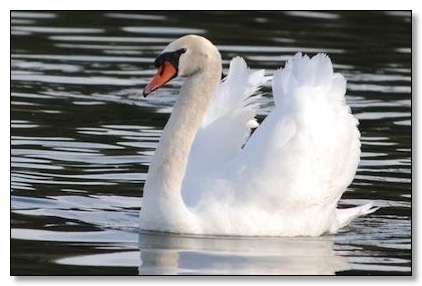The Swan
Article and photograph by D.W. Cloud

The plumage of the male and female are alike, but the males are generally bigger and heavier.
Unlike most birds, swans have small jagged “teeth” as part of their beaks which they use for catching and eating fish, though their diet is largely vegetarian.
The adult male is called a cob, and the female, a pen. The baby swan is a signet or cygnet, and a group of cygnets or eggs is a clutch. A group of swans is called a bevy or lamentation or herd, and a group in flight is called a wedge.
Most species of swans are migratory.
Swans mate for life or at least for many years and build on the same nest each season. During the mating ritual, the male and female touch bill-to-bill and beast-to-breast to form a heart shape, as well as gently intertwining their long necks.
The nest is about three feet across and is built on the ground near water. Unlike most ducks and geese, the male swan helps build the nest as well as assists in incubating the eggs. The baby swan hatches in just over a month and swims with its mother within a couple of days. Gray at birth, it becomes white in about a year.
Both the female and the male swan with eggs or chicks are fierce opponents of any perceived threat and can inflict serious injuries with their strong wings. The male will try to drown another swan that comes into its territory during this time.
Most of the six or seven species of swans are white, but the Australian black swan is black with white on the wings and has a red bill, and the South American black-necked swan is white with a black neck and head.
The black swan swims with one leg, the other being tucked above it’s tail. “This helps it to change direction more smoothly when the swan is swimming on the surface of the water.”
Mute swans on the River Thames are caught, marked, and released each July. This dates from the 12th century, when the Crown claimed ownership of all unmarked mute swans. The first pair had been given to Richard the Lion-Hearted for his part in the Crusades. During the era of the Tudor kings (e.g., Henry VIII), swan meat was regarded as a delicacy and was featured in royal banquets.
The mute swan is a tourist attraction in Lake Morton in Lakeland, Florida. Not native to the area, some were brought in as pets in the 1920s but the small population had died out by 1954. Responding to a plea for help, Queen Elizabeth II donated two royal swans to the city, and the birds made a dramatic come back from that original pair. Each year the city rounds up its 80 or so swans for a health check and vaccinations.


